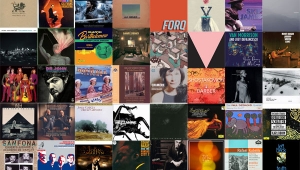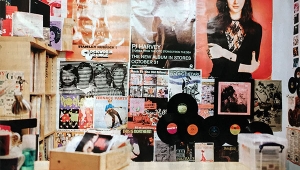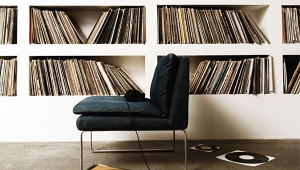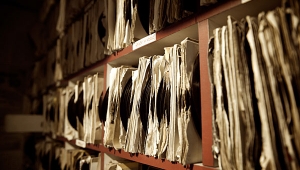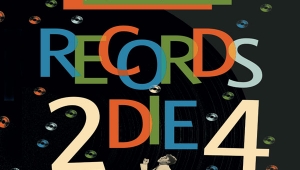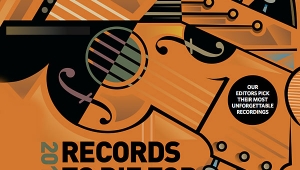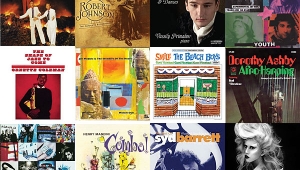| Columns Retired Columns & Blogs |
1996 Records To Die For Page 15
Robert E. Benson
KORNGOLD: Sinfonietta, Sursum Corda
Matthias Bamert, BBC Philharmonic Orchestra
Chandos CHAN 9317 (CD only). Ralph Couzens, prod.; Don Hartridge, eng. DDD. TT: 62:42
Both works are products of Korngold's youth: Sinfonietta was completed in 1912 when he was 15, Sursum Corda seven years later. Sinfonietta is a full-scale, 43-minute symphony for large orchestra, majestic in themes and masterfully orchestrated, premiered in 1913 with Weingartner conducting the Vienna Philharmonic.
MALCOLM ARNOLD: Symphonies 5 & 6
Richard Hickox, London Symphony
Chandos CHAN 9385 (CD only). Brian Couzens, prod.; Ralph Couzens, eng. DDD. TT: 57:46
The brilliance and wit of Sir Malcolm Arnold's lighter works (English Dances, overtures, concertos, ballet music) are evident as well in his symphonies, though often with an ominous undercurrent. Symphony 5 (1961) has a basically tragic atmosphere including in its four movements a Mahlerian funeral march, a brilliant scherzo, and a jubilant finale that reaches an impressive climax only to die away softly with tolling bells. Symphony 6 (1967) is less demanding, its two outer movements contrasted with a somber march. It is also strongly influenced by jazz, and ends with triumphant bells very different from those that end Symphony 5. Hickox's leadership is outstanding, and few recordings have the stunning brass sonorities heard here. It's wonderful to hear the bold French horns, trombones that rasp, and the true, brilliant sound of the trumpets. Arnold's kaleidoscopic scoring presents an! engineering challenge entirely met by Chandos.
Carl Baugher
TOM RAPP: Stardancer
Blue Thumb BTS-44 (LP only). Thomas D. Rapp, prod.; Gene Eichelberger, eng. AAA. TT: 36:45
An all but forgotten masterpiece, Stardancer was the next-to-last release from the man behind Pearls Before Swine. Yet to be reissued in any format, this album appeared briefly in 1972 and immediately went out of print. Pity, because it contains the finest, most chilling anti$nVietnam War song ever written, the shattering "Fourth Day of July." Rapp's writing peaked with lines like, "A line of ghostly children upon the White House lawn / Grown men did turn away, not to see it anymore / To see the burning child running to the White House door." The title track and "The Baptist" are almost as good. Stardancer is a resilient and enduring slice of masterful singer/songwriter art. Sonics are superb---the record emanated from Nashville with a cast of topnotch session players. Unforgettable.
ROBBIE ROBERTSON/RED ROAD ENSEMBLE: Music for The Native Americans
Capitol CDP 8 28295 2 (CD only). Robbie Robertson, prod.; Patrick McCarthy, eng. ??D. TT: 54:30
Despite being somewhat under-valued by fans and critics alike, Robertson's solo albums represent an excellent body of work. This music, composed for the TBS television documentary The Native Americans, is an unprecedented marriage of Native American roots music and modern electric instrumental conjuring. While Robertson often relaxes into the role of guitarist/producer, this album is, like his best work, a collaborative effort. His vocals and moving lyrics on songs like "Ghost Dance" and "It Is A Good Day To Die" are among the highlights of a stunning album. Bass and soundstaging, in particular, are of reference quality. Deep and essential music.
John Atkinson
"So many recordings; so little time!" runs the shortened version of the Official Stereophile Oath mentioned by Richard Lehnert in his introduction. And the truth underlying this simple statement is always brought home to me when RL asks me why I'm always the last Stereophile writer to give him my R2D4 text. I try to grab a couple of extra days by asking him to run the list in reverse alphabetical order---Oh, the joy of having a name beginning with "A"---but the real problem is that it's always an all-but-impossible task to narrow the list of candidates down to just two. Here are my nominees, but there could have been many, many more.
GINGER BAKER TRIO: Going Back Home
Ginger Baker, drums; Bill Frisell, electric guitar; Charlie Haden, bass
Atlantic 82652-2 (CD only). Chip Stern, prod.; Ginger Baker, Yves Beauvais, co-prods.; Malcolm Cecil, Steve Holroyd, engs. A?D. TT: 45:10
Recommended to me first by Wes Phillips, then by Lonnie Brownell, this 1994 album spent a lot of time spinning in the Levinson '31 in '95. The minute you hear that bighearted, loose-limbed drumming bursting from your speakers, you know a precision-perfect drum machine Ginger ain't. But unlike a drum machine, every time Ginger's sticks touch the heads of his Ludwig kit, mighty music is made. As Michael Ross noted in his Stereophile review, the players leave plenty of space for ideas to develop. Add the large, rich, round sound of Charlie Haden's double bass, the acid-edged tone of Bill Frisell's stereo Mesa Boogie-amplified guitar, mix in some originals from each member of the trio and some standards like Thelonious Monk's "Straight No Chaser" and Ornette Coleman's "Ramblin,' " and you have an album that swings like a good'un. Audiophile-quality sound is live to two-track courtesy of Ocean Way Studios. The only departure from jazz proper is a poem GB penned about the West-condoned genocide that has taken place in East Timor since 1980, where Baker's London monotone---remember Wheels of Fire's "Pressed Rat and Warthog"?---is supported by a slowly building instrumental blues freakout equal to anything Cream recorded. (XVIII-1)
VAUGHAN WILLIAMS: Norfolk Rhapsody No.1 in e, In the Fen Country, Fantasia on a Theme by Thomas Tallis for Double String Orchestra, Five Variants of "Dives and Lazarus"
Bryden Thomson, London Philharmonic Orchestra
Musical Heritage Society MHS 512595 (CD only). Brian Couzens, prod.; Ralph Couzens, Philip Couzens, engs. DDD. TT: 59:18
When life is getting on top of me, this luscious-sounding 1986 Chandos recording of four very-English tone poems always puts me back on my feet. These haunting evocations of the English countryside and English spirit, based heavily on folk songs collected by the composer, depend very much on the pure beauty of the orchestral sound to get their message across. With the luminous ambience of All Saints Church in Tooting, South London adding a rich bloom to the sound of the LPO, the necessary beauty is present in abundance. Some might find the recording's luscious tonal colors to be somewhat at odds with the austerity of the East Anglian landscapes depicted in the music, but hey, "truth is beauty, beauty truth."
KORNGOLD: Sinfonietta, Sursum Corda
Matthias Bamert, BBC Philharmonic Orchestra
Chandos CHAN 9317 (CD only). Ralph Couzens, prod.; Don Hartridge, eng. DDD. TT: 62:42
Both works are products of Korngold's youth: Sinfonietta was completed in 1912 when he was 15, Sursum Corda seven years later. Sinfonietta is a full-scale, 43-minute symphony for large orchestra, majestic in themes and masterfully orchestrated, premiered in 1913 with Weingartner conducting the Vienna Philharmonic.
Sursum Corda's premiere was a failure; it was considered "too modern." Filled with sweeping themes, it is about struggle, aspiration, and deliverance. Two decades later Korngold used much of this in his Oscar-winning score for The Adventures of Robin Hood. The manifold difficulties of both scores are superbly set by the fine orchestra under Bamert's strong direction. Chandos's engineering beautifully captures Korngold's rich orchestration. Strings are full and sensuous, brass is powerful, percussion has plenty of impact, , and there is an overall bigness of sound entirely appropriate for the music.
MALCOLM ARNOLD: Symphonies 5 & 6
Richard Hickox, London Symphony
Chandos CHAN 9385 (CD only). Brian Couzens, prod.; Ralph Couzens, eng. DDD. TT: 57:46
The brilliance and wit of Sir Malcolm Arnold's lighter works (English Dances, overtures, concertos, ballet music) are evident as well in his symphonies, though often with an ominous undercurrent. Symphony 5 (1961) has a basically tragic atmosphere including in its four movements a Mahlerian funeral march, a brilliant scherzo, and a jubilant finale that reaches an impressive climax only to die away softly with tolling bells. Symphony 6 (1967) is less demanding, its two outer movements contrasted with a somber march. It is also strongly influenced by jazz, and ends with triumphant bells very different from those that end Symphony 5. Hickox's leadership is outstanding, and few recordings have the stunning brass sonorities heard here. It's wonderful to hear the bold French horns, trombones that rasp, and the true, brilliant sound of the trumpets. Arnold's kaleidoscopic scoring presents an! engineering challenge entirely met by Chandos.
Carl Baugher
TOM RAPP: Stardancer
Blue Thumb BTS-44 (LP only). Thomas D. Rapp, prod.; Gene Eichelberger, eng. AAA. TT: 36:45
An all but forgotten masterpiece, Stardancer was the next-to-last release from the man behind Pearls Before Swine. Yet to be reissued in any format, this album appeared briefly in 1972 and immediately went out of print. Pity, because it contains the finest, most chilling anti$nVietnam War song ever written, the shattering "Fourth Day of July." Rapp's writing peaked with lines like, "A line of ghostly children upon the White House lawn / Grown men did turn away, not to see it anymore / To see the burning child running to the White House door." The title track and "The Baptist" are almost as good. Stardancer is a resilient and enduring slice of masterful singer/songwriter art. Sonics are superb---the record emanated from Nashville with a cast of topnotch session players. Unforgettable.
ROBBIE ROBERTSON/RED ROAD ENSEMBLE: Music for The Native Americans
Capitol CDP 8 28295 2 (CD only). Robbie Robertson, prod.; Patrick McCarthy, eng. ??D. TT: 54:30
Despite being somewhat under-valued by fans and critics alike, Robertson's solo albums represent an excellent body of work. This music, composed for the TBS television documentary The Native Americans, is an unprecedented marriage of Native American roots music and modern electric instrumental conjuring. While Robertson often relaxes into the role of guitarist/producer, this album is, like his best work, a collaborative effort. His vocals and moving lyrics on songs like "Ghost Dance" and "It Is A Good Day To Die" are among the highlights of a stunning album. Bass and soundstaging, in particular, are of reference quality. Deep and essential music.
John Atkinson
"So many recordings; so little time!" runs the shortened version of the Official Stereophile Oath mentioned by Richard Lehnert in his introduction. And the truth underlying this simple statement is always brought home to me when RL asks me why I'm always the last Stereophile writer to give him my R2D4 text. I try to grab a couple of extra days by asking him to run the list in reverse alphabetical order---Oh, the joy of having a name beginning with "A"---but the real problem is that it's always an all-but-impossible task to narrow the list of candidates down to just two. Here are my nominees, but there could have been many, many more.
GINGER BAKER TRIO: Going Back Home
Ginger Baker, drums; Bill Frisell, electric guitar; Charlie Haden, bass
Atlantic 82652-2 (CD only). Chip Stern, prod.; Ginger Baker, Yves Beauvais, co-prods.; Malcolm Cecil, Steve Holroyd, engs. A?D. TT: 45:10
Recommended to me first by Wes Phillips, then by Lonnie Brownell, this 1994 album spent a lot of time spinning in the Levinson '31 in '95. The minute you hear that bighearted, loose-limbed drumming bursting from your speakers, you know a precision-perfect drum machine Ginger ain't. But unlike a drum machine, every time Ginger's sticks touch the heads of his Ludwig kit, mighty music is made. As Michael Ross noted in his Stereophile review, the players leave plenty of space for ideas to develop. Add the large, rich, round sound of Charlie Haden's double bass, the acid-edged tone of Bill Frisell's stereo Mesa Boogie-amplified guitar, mix in some originals from each member of the trio and some standards like Thelonious Monk's "Straight No Chaser" and Ornette Coleman's "Ramblin,' " and you have an album that swings like a good'un. Audiophile-quality sound is live to two-track courtesy of Ocean Way Studios. The only departure from jazz proper is a poem GB penned about the West-condoned genocide that has taken place in East Timor since 1980, where Baker's London monotone---remember Wheels of Fire's "Pressed Rat and Warthog"?---is supported by a slowly building instrumental blues freakout equal to anything Cream recorded. (XVIII-1)
VAUGHAN WILLIAMS: Norfolk Rhapsody No.1 in e, In the Fen Country, Fantasia on a Theme by Thomas Tallis for Double String Orchestra, Five Variants of "Dives and Lazarus"
Bryden Thomson, London Philharmonic Orchestra
Musical Heritage Society MHS 512595 (CD only). Brian Couzens, prod.; Ralph Couzens, Philip Couzens, engs. DDD. TT: 59:18
When life is getting on top of me, this luscious-sounding 1986 Chandos recording of four very-English tone poems always puts me back on my feet. These haunting evocations of the English countryside and English spirit, based heavily on folk songs collected by the composer, depend very much on the pure beauty of the orchestral sound to get their message across. With the luminous ambience of All Saints Church in Tooting, South London adding a rich bloom to the sound of the LPO, the necessary beauty is present in abundance. Some might find the recording's luscious tonal colors to be somewhat at odds with the austerity of the East Anglian landscapes depicted in the music, but hey, "truth is beauty, beauty truth."
I'm always a bit suspicious of Chandos's engineering, having heard stories of artificial reverb being used to sweeten an otherwise dry sound, but no matter: I feel this recording is an object lesson in how engineers can make use of a venue's acoustic to best serve the music. Solo instruments such as the bubbling clarinet that sets the stage for the First Norfolk Rhapsody, and the harp that punctuates Dives and Lazarus, are set back within the hall ambience without sounding muddy or confused. I haven't been able to get hold of the Chandos original, but the MHS transfer seems to have been carefully done, to judge from the grain-free treble and good stage depth. Only sold direct by The Musical Heritage Society, 1710 Highway 35, Ocean, NJ 07712.
- Log in or register to post comments





